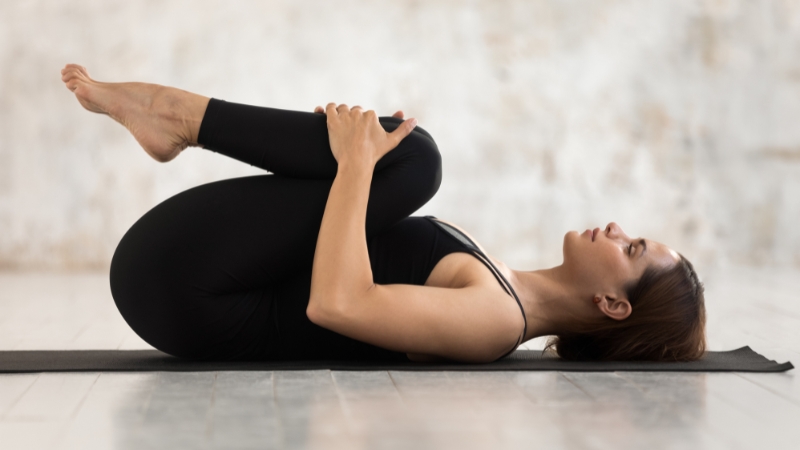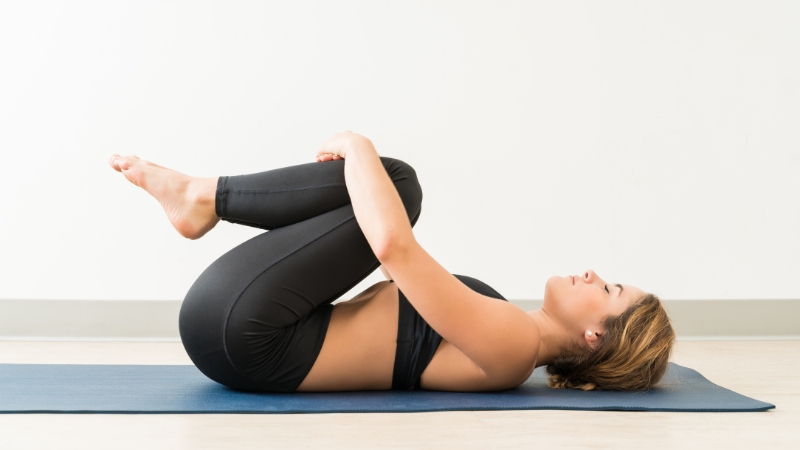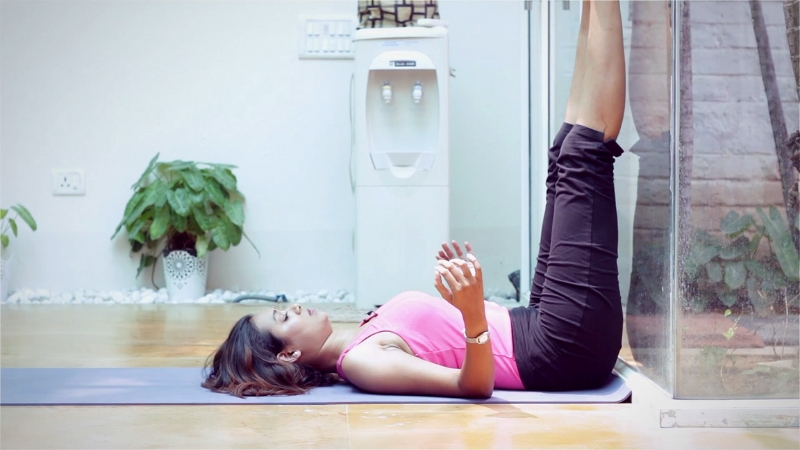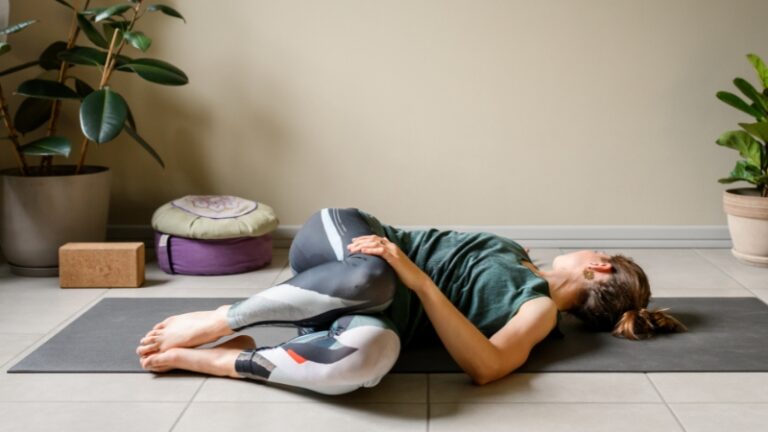Most people know the feeling of finishing a meal and then dealing with an uncomfortable heaviness in the stomach. Bloating can leave you sluggish, gassy, and restless. While diet plays a big role, the body’s ability to process food smoothly is also linked to movement, circulation, and nervous system balance.
This is where yoga stands out. Certain poses naturally compress, stretch, and relax the digestive system, making it easier for food to move along and reducing the trapped air that causes pressure.
Unlike quick fixes like antacids or over-the-counter gas relief tablets, yoga tackles the root causes of sluggish digestion, helping the intestines activate, calming the nervous system, and improving blood flow to abdominal organs. The result is a safe, drug-free method to ease bloating that you can practice daily in just 15–20 minutes.
The digestive system is not just a series of tubes processing food; it is highly sensitive to stress, posture, and circulation. When you sit at a desk all day, eat quickly, or deal with tension, the intestines can become sluggish and less efficient.
Yoga addresses this on multiple levels. Twisting postures act like a gentle internal massage, compressing the stomach and intestines before releasing them, which stimulates peristalsis (the natural muscle contractions that push food through).
7 Best Yoga Poses for Digestion and Bloating Relief
Below are some of the most effective yoga poses for digestion, with practical guidance on how to do them, why they work, and how long to hold them.
1. Apanasana (Knees-to-Chest Pose)

This pose is sometimes jokingly called the “wind-relieving pose,” and for good reason. By drawing the knees into the chest, you place direct pressure on the abdomen, which helps stimulate the colon and intestines.
The gentle rocking motion massages the lower belly and encourages the release of trapped gas, which is often the main culprit behind post-meal bloating. It’s also a calming pose that anyone can do, even right before bed, to soothe both the body and mind.
Pose
How to Do It
Benefits
Time
Apanasana (Knees-to-Chest)
Lie flat on your back, bend your knees, and hug them into your chest with both arms. Keep your lower back pressed into the mat. Gently rock side to side for an added massage.
Relieves gas buildup, stimulates bowel movement, eases bloating and heaviness after meals.
1–2 minutes
2. Supta Matsyendrasana (Supine Spinal Twist)
Twists are particularly effective for digestion because they wring out the abdominal orgas, improving blood flow and encouraging the intestines to contract and release.
When you twist to one side, you compress the colon, and when you return to the center, fresh blood flows back in, carrying oxygen and nutrients that aid in digestion. This flushing effect helps prevent food stagnation and can reduce discomfort after a large meal.
Pose
How to Do It
Benefits
Time
Supine Spinal Twist
Start on your back. Draw both knees to your chest, then let them fall to one side while extending your arms out in a T-shape. Keep your shoulders grounded and turn your head in the opposite direction.
Stimulates peristalsis, improves elimination, relieves bloating, eases lower back tension linked to digestive stress.
1–2 minutes per side
3. Setu Bandhasana (Bridge Pose)

Bridge pose is more than just a backbend. By lifting the hips, you create space in the abdominal cavity, reducing pressure in the stomach and allowing the digestive organs to shift into a more optimal position.
It also engages the core and pelvic muscles, which indirectly strengthen the support system around the intestines. Practicing bridge pose after meals is especially useful when bloating comes with discomfort in the lower back, since the posture also stretches and releases the spine.
Pose
How to Do It
Benefits
Time
Bridge Pose
Lie on your back with knees bent and feet hip-width apart. Press your feet into the ground and slowly lift your hips. Keep your chest open and arms alongside the body.
Reduces abdominal heaviness, improves circulation, eases lower back discomfort, and supports better digestion.
30–60 seconds
4. Balasana (Child’s Pose)
View this post on Instagram
Child’s pose is a simple but powerful posture. Folding the torso over the thighs naturally applies pressure to the belly, which can help move food and gas along the digestive tract. At the same time, it’s an extremely grounding pose that quiets the mind.
Since stress is a major factor in indigestion, using child’s pose as part of your post-meal yoga can bring double benefits: a calmer nervous system and a lighter stomach.
Pose
How to Do It
Benefits
Time
Child’s Pose
Kneel on the floor with big toes touching and knees slightly apart. Sit back onto your heels and fold forward, resting your forehead on the mat with arms extended.
Calms the nervous system, massages the abdomen, relieves gas and indigestion caused by stress.
2–3 minutes
5. Pavanamuktasana (One-Leg Wind-Relieving Pose)

This variation of knees-to-chest focuses on one leg at a time, which stimulates different parts of the colon. Hugging the right knee helps release pressure in the ascending colon, while hugging the left knee targets the descending colon.
Alternating between sides can be especially helpful for people who feel bloated after heavy or greasy meals, because it encourages more complete elimination.
Pose
How to Do It
Benefits
Time
One-Leg Wind-Relieving Pose
Lie on your back and hug your right knee into your chest while keeping the left leg straight. Switch sides after a minute.
Promotes movement through the colon, helps reduce bloating and constipation, and targets trapped gas.
1 minute per side
6. Ardha Matsyendrasana (Seated Spinal Twist)
@knowyogawithjessYPOTW: Ardha Matsyendrasana aka Half Lord of the Fishes. Or for the sake of ease lets call it a seated twist 😅 Suitable for all levels of practice including beginners, this seated twist is excellent to do after a long day of sitting. BEGINNERS TIPS: ☝️If your shoulders are tight, try hugging your knee with your hand instead of hooking your elbow. ✌️If your hips are tight, try extending your opposite leg out long to help keep both hips grounded on the mat. Give it a try and let me know what you think!♬ original sound – know yoga with Jess
This seated twist is a practical option even when you are not on a yoga mat. You can do it while sitting on the floor or even in a chair at work. Twisting the torso compresses and then releases the abdominal organs, encouraging digestion.
Since it also improves posture, it helps counteract the slouched position that often makes bloating worse after meals. It’s an excellent pose for people who want relief but don’t have time for a full yoga session.
Pose
How to Do It
Benefits
Time
Seated Spinal Twist
Sit with both legs extended. Cross your right foot over your left thigh, bend the left knee if comfortable, and place your right hand behind you. Twist gently toward the right.
Stimulates abdominal organs, reduces gas and bloating, and improves posture that aids digestion.
1–2 minutes per side
7. Viparita Karani (Legs-Up-the-Wall Pose)

Unlike the active poses above, this is a deeply restorative posture that uses gravity to help the digestive system. By raising the legs above the stomach, blood and lymphatic fluid flow back toward the core, reducing swelling and improving circulation to the gut.
It also calms the mind and activates the body’s relaxation response, which is critical for digestion. Holding this pose for several minutes after eating can significantly reduce bloating and leave you feeling lighter.
Pose
How to Do It
Benefits
Time
Legs-Up-the-Wall
Sit close to a wall, lie back, and swing your legs up so they rest against it. Keep arms relaxed by your sides.
Improves circulation, reduces bloating and water retention, deeply relaxes the digestive system.
5–10 minutes
Tips for Practicing Yoga for Digestion
Yoga for digestion works best when practiced mindfully. Always give yourself at least 30–60 minutes after eating before trying active poses like twists or bridge pose, since doing them too soon can feel uncomfortable.
Gentle, restorative postures like Legs-Up-the-Wall or Child’s Pose can be practiced sooner if you feel immediate bloating.
Breathing is equally important – try slow belly breathing, expanding your abdomen as you inhale and softening it as you exhale. This not only enhances the massage effect of each pose but also signals your nervous system to shift into digestion mode.
Finally, pair your yoga with hydration – warm water or herbal teas like ginger, fennel, or peppermint work well alongside movement to soothe the stomach.
Bottom Line
Bloating after meals doesn’t have to ruin your day. While diet adjustments are important, yoga offers a simple, natural, and sustainable way to improve digestion and ease discomfort.
Poses like Apanasana, spinal twists, and Legs-Up-the-Wall bring together physical stimulation and nervous system relaxation, making them highly effective against post-meal heaviness.
A short 15–20 minute yoga routine practiced consistently can help you not only relieve bloating when it happens but also support long-term digestive health.

